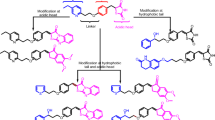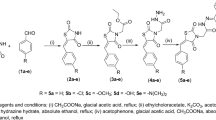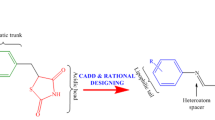Abstract
A series of novel substituted 5-(aryl-alkoxy-benzylidine)-imidazolidine-2,4-diones (4a–f, 5a) were designed and evaluated as selective PPARγ agonists analogous to the reference lead, rosiglitazone (II). The molecular modeling compare/Fit study of these molecules with the PPARγ agonists’ pharmacophore constructed from known PPARγ agonists and the docking scores of the same designed molecules using the 3D protein crystal structure of the PPARγ receptors were determined. The fit scores of these molecules were more or less similar to the reference drug (II), while the reduced molecule 5a gave highest fit value. The docking scores of molecules 4c–f and 5a were higher than the lead II. These hit molecules were subsequently synthesized and evaluated for their in vivo anti-hyperglycemic activity in hyperglycemic animal model. Compounds 4a–e showed similar or slightly higher activity than the lead drug II. In contrast, the activities of compounds 4f and 5a were 1.2- and 1.3-folds higher than the same lead.









Similar content being viewed by others
References
Ahn JH, Jung SH, Yang SD (2004) Synthesis and DP-IV inhibition of cyano-pyrazoline derivatives as potent anti-diabetic agents. Bioorg Med Chem Lett 14(17):4461
Apodaca R, Dvovak CA, Xiao W, Barbier AJ, Boggs JD, Wilson SJ, Lovenberg TW, Carruthers NI (2003) A new class of diamine-based human histamine H3 receptor antagonists: 4-(aminoalkoxy)benzylamines. J Med Chem 46:3938
Arakawa K, Inamasu M, Matsumoto M, Okumura K, Yasuda K (1984) Novel benzoxazole 2,4-thiazolidinediones as potent hypoglycemic agents. Synthesis and structure-activity relationships. Chem Pharm Bull 1997:45
Bauer L, Welsh TL (1962) The synthesis of derivatives of α-mercaptoamidines. J Org Chem 27:4382
Berger J, David E (2002) The mechanisms of action of PPARs. Annu Rev Med 53(1):409–435
Bernardon JM, Clary L (2002) (Galerma Research and Development, Fr.) preparation of biphenyl derivatives and their use as PPARγ receptor agonist. PCT Int Appl, 113 pp
Cantello BC, Cawthorne MA, Cottam GP, Duff PT, Smith SA, Thurlby PL (1994) [Omega-(Heterocyclylamino)alkoxy]benzyl]-2,4-thiazolidinediones as potent antihyperglycemic agents. J Med Chem 37:3977
Cowie CC, Eberhardt MS (1996) Diabetes vital statistics. American Diabetes Association, Alexandria
Cronet P, Peterson JF, Folmer R (2001) Structure of the PPARalpha and -gamma ligand binding domain in complex with AZ 242: ligand selectivity and agonist activation in the PPAR family. Structure (Camb) 9:699
Ellingboe JW, Alessi TR, Dolak TM, Nguyen TT, Tomer JD, Guzzo F, Bagli JF, McCaleb ML (1992) Antihyperglycemic activity of novel substituted 3H-1,2,3,5-oxathiadiazole 2-oxides. J Med Chem 35(7):1176–1183
Fan X, Zhang X, Zhou L (2006) A pyrimidine-pyrazolone nucleoside chimera with potent in vitro anti-orthopoxvirus activity. Bioorg Med Chem Lett 16:3224
Fujita T, Sugiyama Y, Taketomi S, Sohda T, Kawamatsu Y, Iwatsuka H, Suzuoki Z (1983) Reduction of insulin resistance in obese and/or diabetic animals by 5-[4-(1-methylcyclohexylmethoxy)benzyl]-thiazolidine-2,4-dione (ADD-3878, U-63,287, ciglitazone), a new antidiabetic agent. Diabetes 32:804
Genuth S (1990) Insulin use in NIDDM. Diabetes Care 13:1240
Gewald K (1965) Heterocycles from CH-acidic nitriles. VII. 2 Aminothiophene from α-oxo mercaptans and methylene-active nitriles. Chem Ber 98:3571
Goldstein SW, McDermott RE, Gibbs EM (1993) Hydroxyurea derivatives as hypoglycemic agents. J Med Chem 36:2238
Henke BR, Blanchard SG, Lehman JM (1998) N-(2-Benzoylphenyl)-l-tyrosine PPARgamma agonists. 1. Discovery of a novel series of potent antihyperglycemic and antihyperlipidemic agents. J Med Chem 41:5020
Hulin B, Clark DA, Goldstein SW, McDermott RE, Dambek PJ, Kappeler WH, Lamphere CH, Lewis DM, Rizzi JP (1992) Novel thiazolidine-2,4-diones as potent euglycemic agents. J Med Chem 35(10):1853–1864
Hulin B, Newton LS, Lewis DM, Genereux PE, Gibbs EM, Clark DA (1996) Hypoglycemic activity of a series of alpha-alkylthio and alpha-alkoxy carboxylic acids related to ciglitazone. J Med Chem 39:3897
Keneth AJ, William LP, John DW (1985) Functionalized congeners of 1,3-dialkylxanthines: preparation of analogs with high affinity for adenosine receptors. J Med Chem 28(9):1334
Kulkarni SS, Lalji KG, Kulkarni VM (1999) Three-dimensional quantitative structure activity relationships (3-D-QSAR) of antihyperglycemic agents. Bioorg Med Chem 7:1475
Lazer ES, Wong HC, Graham AG (1989) Antiinflammatory 2,6-di-tert-butyl-4-(2-arylethenyl)phenols. J Med Chem 32:100
Lee JY, Park WH, Yun HJ (2005) Design and synthesis of novel antidiabetic agents. Arch Pharm Res 28(2):142
Lehman JM, Moore LB, Wilkison WO (1995) An antidiabetic thiazolidinedione is a high affinity ligand for peroxisome proliferator-activated receptor γ (PPARγ). J Biol Chem 270:12953
Lohray BB, Bhushan V, Reddy AK (1998) Novel euglycemic and hypolipidemic agents. J Med Chem 41:1619
Mariapan G, Saha BP, Sripana D, Deepak K, Haldar PK (2011) Design synthesis and antidiabetic evaluation of oxazolone derivatives. J Chem Sci 123(3):335–341
Marton J, Enisz J, Hosztafi S, Timar T (1993) Preparation and fungicidal activity of 5-substituted hydantoins and their 2-thio analogs. J Agric Food Chem 41:148
Matsueda H, Ohsumi K (2003) Pyrazole-O-glucosides as novel Na(+)-glucose cotransporter (SGLT) inhibitors. Bioorg Med Chem Lett 13(14):2269
Mirviss SB, Dahod SK, Empie MW (1990) Synthesis of l-phenylalanine methyl ester. Ind Eng Chem Res 29:651
Mohamed Ismail MA, El Ella DAA, Abouzid KAM, Jaballah M (2012) Design synthesis and virtual screening of certain 2-pyrazolin-5-one and Pyrazolidine-3, 5-dione derivatives as potential PPARγ agonists. IJPSR 3(10):3746–3757
Momose Y, Maekawa T (2002) Novel 5-substituted 2,4-thiazolidinedione and 2,4-oxazolidinedione derivatives as insulin sensitizers with antidiabetic activities. J Med Chem 45:1518
Momose Y, Odaka H (2002) Novel 5-substituted-1H-tetrazole derivatives as potent glucose and lipid lowering agents. Chem Pharm Bull 50(1):100
Nolte RT, Wisely GB, Westin S, Cobb JE, Glass CK (1998) Ligand binding and co-activator assembly of the peroxisome proliferator-activated receptor-γ. Nature 395:137–143
Oguchi H, Wada K (2000) Molecular design, synthesis, and hypoglycemic activity of a series of thiazolidine-2,4-diones. J Med Chem 43:3052–3066
Olefsky JM, Kolterman OG (1981) Mechanisms of insulin resistance in obesity and noninsulin-dependent (type II) diabetes. Am J Med 70:151–168
Reaven GM (1980) Insulin-independent diabetes mellitus: metabolic characteristics. Metabolism 29:445–454
Reaven G (1988) Role of insulin resistance in human disease. Diabetes 37:1595–1607
Sauerberg P, Pettersson I (2002) Novel tricyclic-alpha-alkyloxyphenylpropionic acids: dual PPARalpha/gamma agonists with hypolipidemic and antidiabetic activity. J Med Chem 45:789
Selles P, Wailes JS, Whittingham WG, Clark ED (2005) Fungicides: US patent, 2005044008 (CA, 142 458555)
Sohda T, Mizuno K, Sugiyama Y, Tawada H, Fujita T, Kawanatsu Y (1982) Studies on antidiabetic agents II. Chem Pharm Bull 30:3580
Sohda T, Momose Y, Meguro K (1990) Studies on antidiabetic agents. Synthesis and hypoglycemic activity of 5-[4-(pyridyl-alkoxy)-benzyl]-2,4 thiazolidinediones. Arzneim-Forsch 40:37
Sohda T, Mizuno K, Momose Y, Ikeda H, Fujita T (1992) Studies on antidiabetic agents. 11. Novel thiazolidinedione derivatives as potent hypoglycemic and hypolipidemic agents. J Med Chem 35:2617
Suzuki T, Igarashi K, Hase K, Tuzimura K (1973) Optical rotatory dispersion and circular dichroism of amino acid hydantoins. J Agric Biol Chem 37(2):411–416
Willson TM, Cobb JE, Cowan DJ, Wiethe RW (1996) The structure–activity relationship between peroxisome proliferator-activated receptor γ agonism and the antihyperglycemic activity of thiazolidinediones. J Med Chem 39:665–668
Willson TM, Brown PJ, Henke BR (2000) The PPARs: from orphan receptors to drug discovery. J Med Chem 43:527
Yanagisawa H, Takamura M, Yamada E, Fujita S, Hagisawa Y (2000) Novel oximes having 5-benzyl-2,4-thiazolidinedione as antihyperglycemic agents: synthesis and structure-activity relationship. Bioorg Med Chem Lett 10:373–375
Zask A, Jirkvosky L, Nowicki JW, McCalev ML (1990) Synthesis and antihyperglycemic activity of novel 5-(naphthalenylsulfonyl)-2,4-thiazolidine-diones. J Med Chem 33:1418
Acknowledgments
We deeply appreciate the efforts of the members of the Biochemistry Department of Faculty of Pharmacy, Damascus University for conducting the anti-hyperglycemic activity study.
Conflict of interest
All the authors have no conflict of interest and no personal relationships or financials with any people or organizations that could inappropriately influence (bias) their work directly or indirectly, during the subject matter or materials discussed in this manuscript.
Ethical guideline
All the experiments that had been performed on experimental animals were conducted by applying the International Ethical Guidelines.
Author information
Authors and Affiliations
Corresponding author
Rights and permissions
About this article
Cite this article
Ismail, M.A.H., Abou El Ella, D.A., Abouzid, K.A.M. et al. Molecular modeling design, synthesis, and anti-hyprglycemic evaluation of certain 5-(aryl-alkoxy-benzylidine)-imidazolidine-2,4-dione derivatives as potential PPARγ agonists. Med Chem Res 24, 2115–2126 (2015). https://doi.org/10.1007/s00044-014-1278-4
Received:
Accepted:
Published:
Issue Date:
DOI: https://doi.org/10.1007/s00044-014-1278-4




